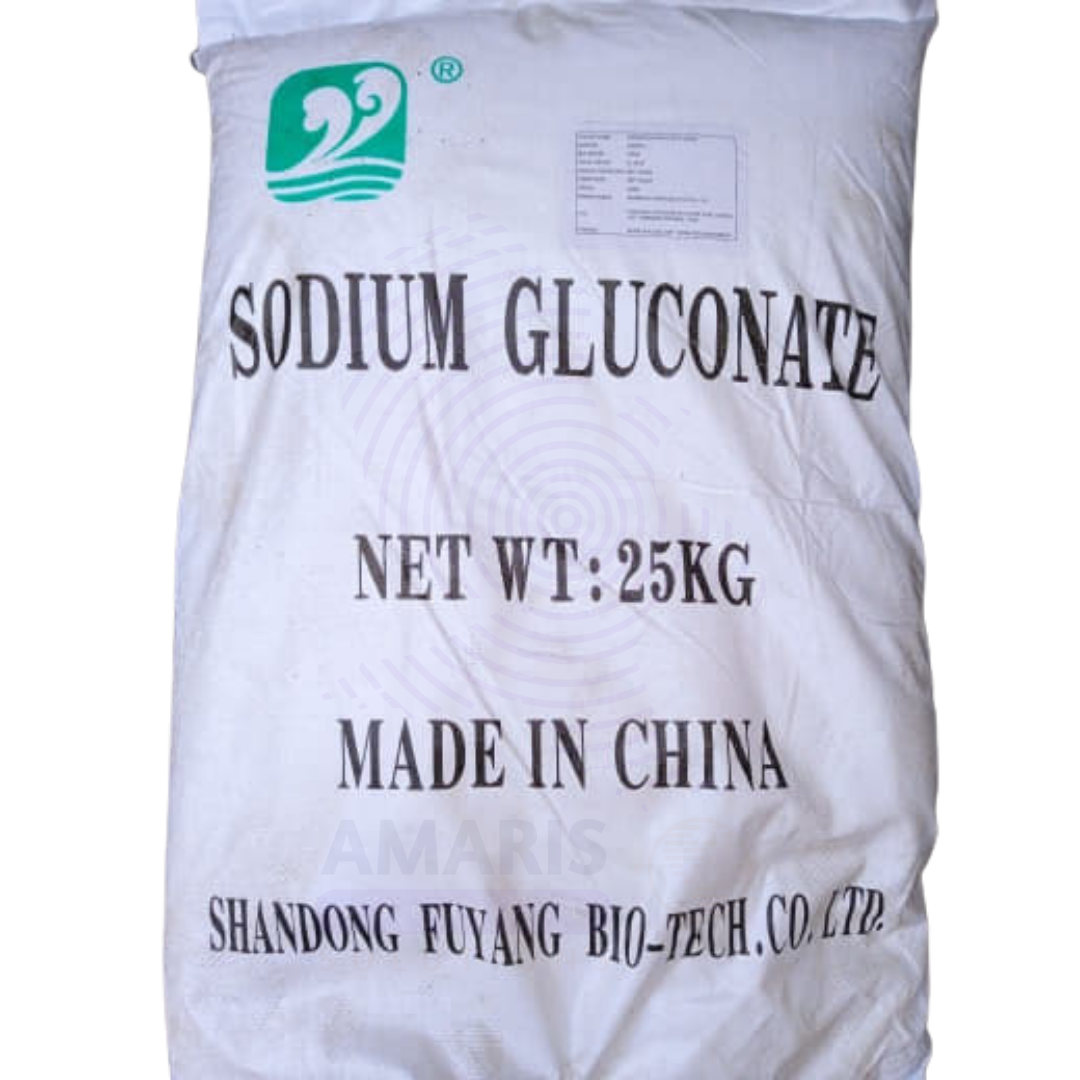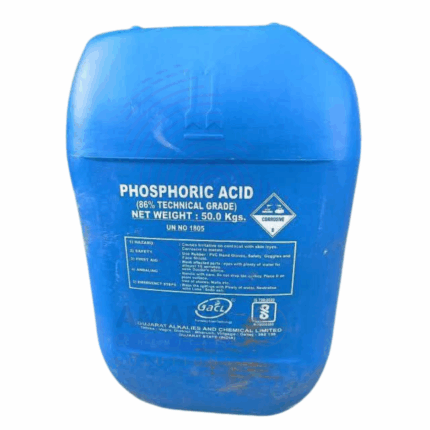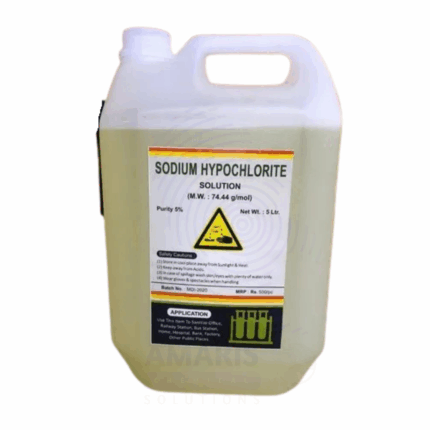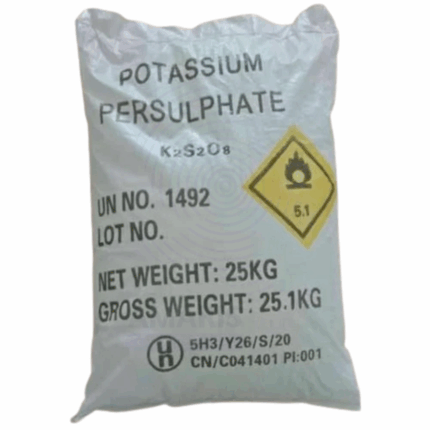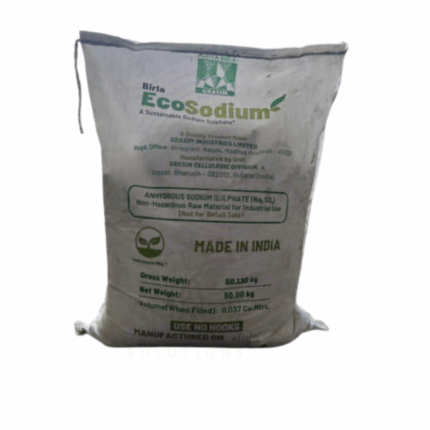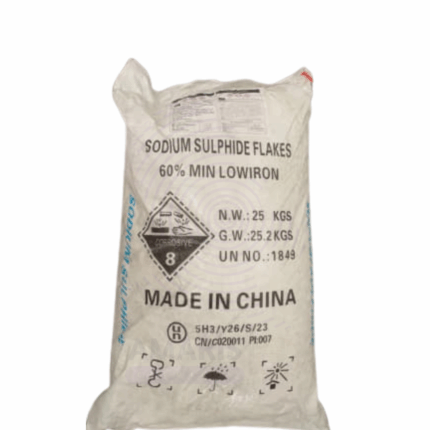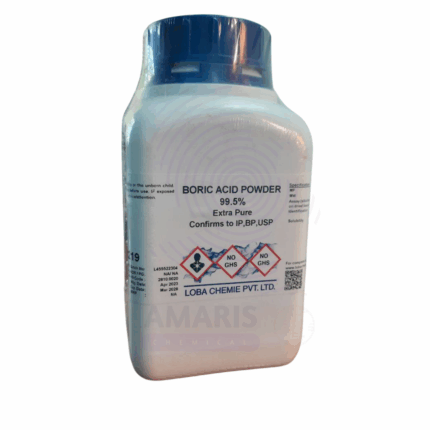
Boric Acid Extra Pure
$ 19.00 Original price was: $ 19.00.$ 18.89Current price is: $ 18.89.
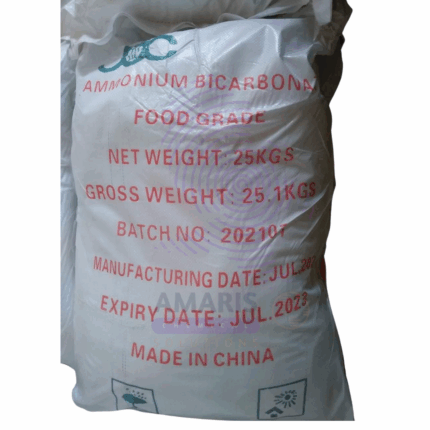
Ammonium Bicarbonate
$ 2.00 Original price was: $ 2.00.$ 1.45Current price is: $ 1.45.
Sodium Gluconate
Whatsapp Order
Sodium Gluconate is a white, crystalline powder derived from gluconic acid and sodium salt. It is highly water-soluble, biodegradable, and non-toxic, widely used as a chelating agent, sequestrant, and buffering agent across various industries. Sodium Gluconate is favored for its excellent ability to bind metal ions, improve cleaning efficiency, and stabilize formulations. It finds extensive applications in construction, water treatment, food, pharmaceuticals, cosmetics, and textiles.
Categories: Analytical Reagents, Builders, Chelating Agents, CLEANING AND DETERGENT CHEMICALS, Excipients, FOOD AND BEVERAGE CHEMICALS, LABORATORY CHEMICALS, PHARMACEUTICAL CHEMICALS, Preservatives(food), WATER TREATMENT CHEMICALS
Tags: C₆H₁₁NaO₇, Detergent and cleaning products, Food additive, Gluconic Acid Sodium Salt, Organic Acid Salt, Sodium Gluconate
Description
Table of Contents
Toggle
Sodium Gluconate
Primary Uses
- Construction Industry
- Acts as a concrete admixture to improve workability, retard setting time, and enhance strength development.
- Functions as a plasticizer and corrosion inhibitor for steel reinforcement in concrete.
- Water Treatment
- Used as a chelating agent to sequester metal ions such as calcium, magnesium, iron, and heavy metals, preventing scale formation and corrosion.
- Applied in industrial and municipal water treatment processes.
- Cleaning Products
- Enhances the effectiveness of detergents and cleaning agents by binding hard water ions, improving cleaning performance.
- Used in household and industrial cleaners.
- Food Industry
- Employed as a sequestrant and acidity regulator in food and beverage formulations.
- Approved for use in some food products to improve stability and shelf life.
- Pharmaceuticals and Cosmetics
- Functions as a stabilizer and chelating agent in pharmaceutical formulations, personal care products, and cosmetics to enhance product stability and efficacy.
- Used in creams, lotions, and oral care products.
- Textile Industry
- Utilized in dyeing and printing processes as a chelating agent to improve color brightness and fixation.
Secondary Uses
- Metal Cleaning and Electroplating
- Used to clean metal surfaces and as a complexing agent in electroplating baths.
- Agriculture
- Acts as a micronutrient chelator in fertilizers to improve nutrient availability.
- Laboratory Applications
- Used as a reagent and stabilizer in chemical and biochemical analyses.
PRODUCT KEY FEATURES
Basic Identification Attributes
- Chemical Name (IUPAC): Sodium gluconate
- Common/Trade Name: Sodium Gluconate
- CAS Number: 527-07-1
- HS Code: 2915.39
- Synonyms: Sodium D-gluconate, D-Gluconic acid sodium salt
Physical & Chemical Properties
- Physical State: Solid (powder or granules)
- Color & Odor: White; odorless
- Solubility: Highly soluble in water
- pH: Approximately 6.5 - 8 (1% aqueous solution)
- Density: Approx. 1.7 g/cm³
Safety & Hazard Attributes
- GHS Classification: Generally regarded as safe; low toxicity
- Toxicity: Low toxicity; non-irritant under normal conditions
- Exposure Limits: Standard industrial hygiene practices recommended
Storage & Handling Attributes
- Storage Conditions: Store in a cool, dry, well-ventilated place, protected from moisture and contaminants
- Container Type: Supplied in sealed bags or drums (25kg or bulk)
- Shelf Life: Stable under proper storage conditions
- Handling Precautions: Avoid inhalation of dust; use protective equipment as necessary
- Storage Measures: Keep containers tightly closed and stored in a dry environment
Regulatory & Compliance Attributes
- Complies with food-grade and pharmaceutical-grade standards where applicable
- Meets REACH, FDA, and other international regulatory requirements
- Manufactured in GMP and ISO-certified facilities
Environmental & Health Impact
- Biodegradability: Readily biodegradable and environmentally friendly
- Ecotoxicity: Low environmental impact when used responsibly
- Bioaccumulation: Not expected to bioaccumulate
SAFETY HANDLING PRECAUTIONS
Safety Handling Precautions
- PPE Required: Use gloves, dust mask, and eye protection when handling powder
- Handling Guidelines: Avoid dust formation and inhalation; ensure good ventilation
- Storage Measures: Store away from incompatible substances like strong oxidizers
First Aid Measures
- Inhalation: Move to fresh air; seek medical attention if respiratory irritation occurs
- Skin Contact: Wash with soap and water; seek medical advice if irritation develops
- Eye Contact: Rinse thoroughly with water for 15 minutes; seek medical help if irritation persists
- Ingestion: Rinse mouth; seek medical attention if large amounts ingested
Firefighting Measures
- Fire Hazards: Non-flammable and non-combustible
- Extinguishing Media: Use water spray, foam, dry chemical, or CO₂ for surrounding fires
- Special Precautions: Wear protective gear
- Hazardous Combustion Products: None known
Related products
Phosphoric acid Technical Grade
Phosphoric Acid Technical Grade is a concentrated, inorganic acid primarily used in industrial applications. It typically contains minor impurities compared to food or pharmaceutical grades but maintains excellent performance as an acidulant, rust remover, and intermediate chemical. This grade is widely used in manufacturing fertilizers, detergents, metal treatment, and other industrial processes where high purity is not critical but effective acidic properties are required.
Sodium Hypochlorite
Sodium Hypochlorite 10-12% (commonly known as Jik) is a clear to pale greenish-yellow liquid with a strong chlorine odor. It is a widely used disinfectant and bleaching agent, known for its powerful oxidizing properties. This grade is commonly employed in household cleaning, water treatment, and industrial sanitation processes. It is effective against a broad spectrum of microorganisms, making it a popular choice for disinfection and sterilization.
Sodium Persulfate
Sodium Persulfate is a white crystalline powder with the chemical formula Na₂S₂O₈. It is a powerful oxidizing agent widely used in industrial and chemical applications. This 25kg packaged product is highly soluble in water and decomposes to release oxygen, making it effective for polymerization, etching, and cleaning processes. Its strong oxidation properties and stability under storage conditions make it a preferred choice for various demanding applications.
Sodium Sulphate
Sodium Sulphate (Na₂SO₄) is a white crystalline powder or granule, odorless and highly soluble in water. This 25kg packaged product is widely used in detergents, glass manufacturing, chemical industries, and pulp and paper processing. It acts as a filler, bulking agent, and drying agent, with excellent stability and non-reactivity under standard storage conditions. Its cost-effectiveness and availability make it an essential raw material in many industrial processes.
Sodium Sulphide
Sodium Sulphide (Na₂S) is a yellow to red-yellow crystalline solid or powder with a characteristic odor of hydrogen sulfide. It is highly soluble in water, forming strongly alkaline solutions. This 25kg packaged product is widely used in the chemical, leather, pulp and paper, and textile industries as a reducing agent, sulfur donor, and in flotation processes. Due to its strong reducing properties and reactivity, it must be handled with care under proper safety measures.
STPP (Granules)
Sodium Tripolyphosphate (STPP) in granulated form is a versatile, high-purity inorganic compound widely used in industrial, cleaning, and food processing applications. Presented as free-flowing white granules, this form offers excellent solubility and ease of handling, making it ideal for automated dosing and blending. Granular STPP is valued for its water-softening, dispersing, emulsifying, and preservative properties, supporting a wide range of formulations across multiple industries.
Sulphonic Acid (LABSA) 90%
Sulphonic Acid, commonly known as Linear Alkyl Benzene Sulphonic Acid (LABSA) 90%, is a high-quality anionic surfactant widely used as a key raw material in the detergent and cleaning products industry. It is produced by sulfonation of linear alkyl benzene, resulting in a biodegradable, highly effective wetting and foaming agent. The 90% concentration grade offers excellent performance in formulation of powders, liquids, and specialty detergents.
Tetrasodium EDTA
v
Tetrasodium EDTA is the tetrasodium salt of ethylenediaminetetraacetic acid, a powerful chelating agent widely used in industrial, personal care, and pharmaceutical applications. It effectively binds metal ions such as calcium and magnesium, preventing their interference in formulations. Its ability to enhance stability, improve efficacy, and prevent microbial growth makes it a multifunctional ingredient in a variety of chemical products.


 Preservatives(food)
Preservatives(food) Flavor Enhancers
Flavor Enhancers Acidulants
Acidulants Sweeteners
Sweeteners Antioxidants
Antioxidants Colorants(food)
Colorants(food) Nutraceutical Ingredients (food)
Nutraceutical Ingredients (food) Nutrient Supplements
Nutrient Supplements Emulsifiers
Emulsifiers
 Collectors
Collectors Dust Suppressants
Dust Suppressants Explosives and Blasting Agents
Explosives and Blasting Agents Flocculants and Coagulants
Flocculants and Coagulants Frothers
Frothers Leaching Agents
Leaching Agents pH Modifiers
pH Modifiers Precious Metal Extraction Agents
Precious Metal Extraction Agents
 Antioxidants(plastic)
Antioxidants(plastic) Colorants (Pigments, Dyes)
Colorants (Pigments, Dyes) Fillers and Reinforcements
Fillers and Reinforcements Flame Retardants
Flame Retardants Monomers
Monomers Plasticizers
Plasticizers Polymerization Initiators
Polymerization Initiators Stabilizers (UV, Heat)
Stabilizers (UV, Heat)
 Antifoaming Agents
Antifoaming Agents Chelating Agents
Chelating Agents Coagulants and Flocculants
Coagulants and Flocculants Corrosion Inhibitors
Corrosion Inhibitors Disinfectants and Biocides
Disinfectants and Biocides Oxidizing Agents
Oxidizing Agents pH Adjusters
pH Adjusters Scale Inhibitors( water)
Scale Inhibitors( water)
 Antioxidants(cosmetic)
Antioxidants(cosmetic) Emollients
Emollients Fragrances and Essential Oils
Fragrances and Essential Oils Humectants
Humectants Preservatives
Preservatives Surfactants(cosmetic)
Surfactants(cosmetic) Thickeners
Thickeners UV Filters
UV Filters
 Fertilizers
Fertilizers Soil Conditioners
Soil Conditioners Plant Growth Regulators
Plant Growth Regulators Animal Feed Additives
Animal Feed Additives Biostimulants
Biostimulants Pesticides (Herbicides, Insecticides, Fungicides)
Pesticides (Herbicides, Insecticides, Fungicides)
 Active Pharmaceutical Ingredients (APIs)
Active Pharmaceutical Ingredients (APIs) Excipients
Excipients Solvents(pharmaceutical)
Solvents(pharmaceutical) Antibiotics
Antibiotics Antiseptics and Disinfectants
Antiseptics and Disinfectants Vaccine Adjuvants
Vaccine Adjuvants Nutraceutical Ingredients (pharmaceutical)
Nutraceutical Ingredients (pharmaceutical) Analgesics & Antipyretics
Analgesics & Antipyretics
 Analytical Reagents
Analytical Reagents Solvents(lab)
Solvents(lab) Chromatography Chemicals
Chromatography Chemicals Spectroscopy Reagents
Spectroscopy Reagents microbiology-and-cell-culture-reagents
microbiology-and-cell-culture-reagents Molecular Biology Reagents
Molecular Biology Reagents Biochemical Reagents
Biochemical Reagents Inorganic and Organic Standards
Inorganic and Organic Standards Laboratory Safety Chemicals
Laboratory Safety Chemicals Specialty Laboratory Chemicals(Special Laboratory Equipment)
Specialty Laboratory Chemicals(Special Laboratory Equipment)
 Demulsifiers
Demulsifiers Hydraulic Fracturing Fluids
Hydraulic Fracturing Fluids Scale Inhibitors(oil)
Scale Inhibitors(oil) Surfactants(oil)
Surfactants(oil) Drilling Fluids
Drilling Fluids
 Dyes and Pigments
Dyes and Pigments Bleaching Agents
Bleaching Agents Softening Agents
Softening Agents Finishing Agents
Finishing Agents Antistatic Agents
Antistatic Agents
 Admixtures
Admixtures Waterproofing Agents
Waterproofing Agents Sealants and Adhesives
Sealants and Adhesives Curing Compounds
Curing Compounds Concrete Repair Chemicals
Concrete Repair Chemicals Anti-Corrosion Coatings
Anti-Corrosion Coatings
 Surfactants(cleaning)
Surfactants(cleaning) Builders
Builders Enzymes
Enzymes Solvents (Cleaning)
Solvents (Cleaning) Fragrances
Fragrances
 Electronic Chemicals
Electronic Chemicals Catalysts
Catalysts Lubricants
Lubricants Photographic Chemicals
Photographic Chemicals Refrigerants
Refrigerants Automotive chemicals
Automotive chemicals Pyrotechnic Chemicals
Pyrotechnic Chemicals
 Biodegradable Surfactants
Biodegradable Surfactants Bio-based Solvents
Bio-based Solvents Renewable Polymers
Renewable Polymers Carbon Capture Chemicals
Carbon Capture Chemicals Wastewater Treatment Chemicals
Wastewater Treatment Chemicals
 Pigments
Pigments Solvents(paint)
Solvents(paint) Specialty Coatings
Specialty Coatings Binders/Resins
Binders/Resins Additives
Additives Driers
Driers Anti-Corrosion Agents
Anti-Corrosion Agents Functional Coatings
Functional Coatings Application-Specific Coatings
Application-Specific Coatings
 Fresh Herbs
Fresh Herbs Ground Spices
Ground Spices Whole Spices
Whole Spices Spice Blends
Spice Blends Dried Herbs
Dried Herbs
 Leavening Agents
Leavening Agents Dough Conditioners
Dough Conditioners Flour Treatments
Flour Treatments Fat Replacers
Fat Replacers Decoratives
Decoratives Preservatives(baking)
Preservatives(baking)
 Plasticizers & Softeners
Plasticizers & Softeners Reinforcing Agents
Reinforcing Agents Adhesion Promoters
Adhesion Promoters Vulcanizing Agents
Vulcanizing Agents Antidegradants
Antidegradants Blowing Agents
Blowing Agents Fillers & Extenders
Fillers & Extenders Accelerators & Retarders
Accelerators & Retarders